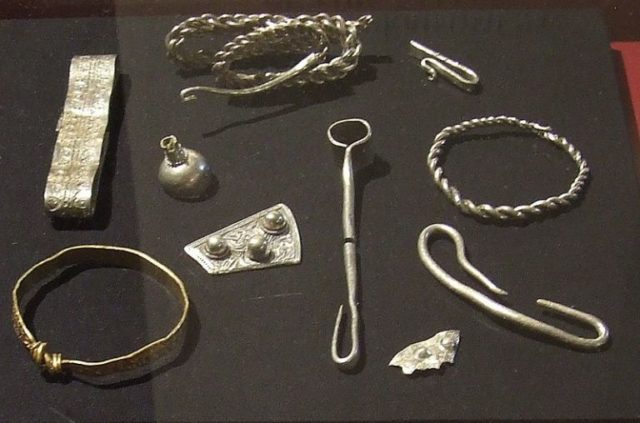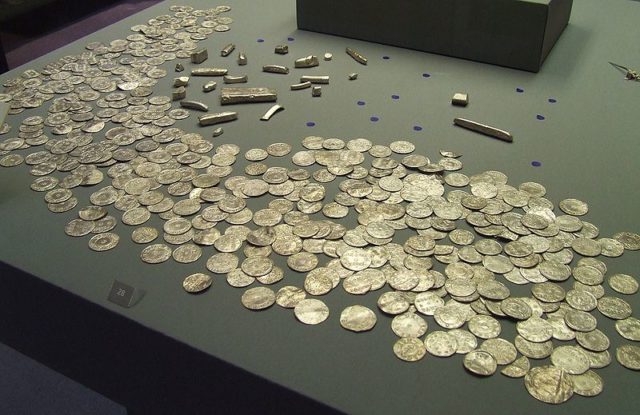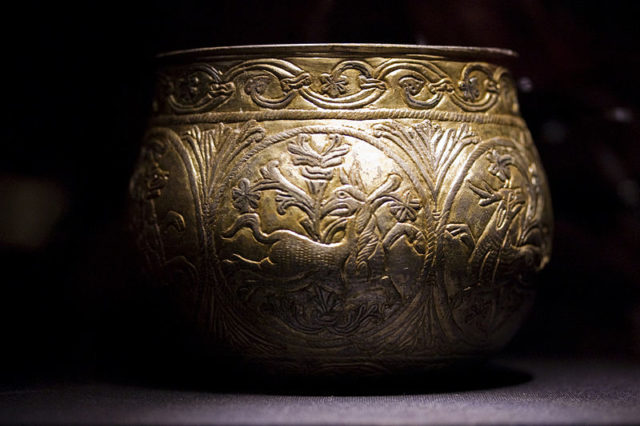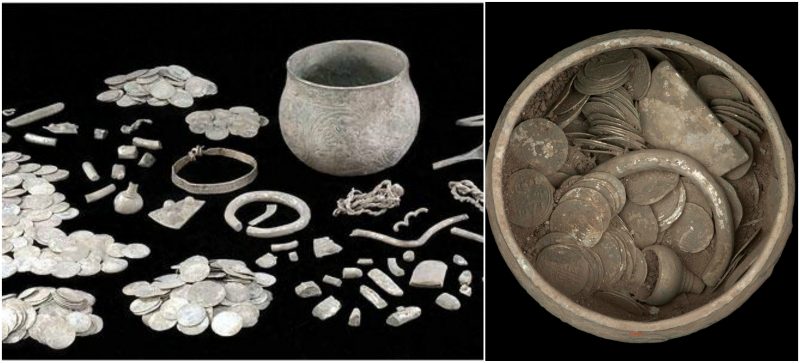On 6 January 2007, metal detector enthusiast David Whelan and his son Andrew discovered the Harrogate Hoard in a newly-plowed field near Harrogate, Yorkshire, England. Having been on this field in the past, they expected to find nothing more than a few Victorian buttons.
David received a signal which prompted him to dig a little, which caused the signal to become stronger. Further digging uncovered pieces of lead and a round object completely covered in mud. The object turned out to be a silver bowl with a few coins visible in the mud. Whelan realized one of the coins was an Anglo-Saxon penny from the reign of Edward the Elder (899—924 AD). The two carefully recorded what they had found and its precise location in the field. This turned out to be a vital step, as when the researchers returned to the recovery site, all evidence of digging had washed away in a storm. They took the cup and the few coins and reported the find to Amy Cooper, Finds Liaison Officer of the Portable Antiquities Scheme.


The 1996 Treasure Act requires that all finds, including objects that are more than 300 years old and are more than 10% gold or silver, must be reported to authorities. The Whelans adhered to the law and not only reported the find to Cooper, but to the landowner as well. They resisted the lure to remove the objects from the bowl and asked only that they be present when the objects were removed for inspection and cleaning. The ability to know the order in which the coins were placed is vital, and thanks to the responsible way the Whelans excavated and turned over the find, researchers will be able to determine when the objects were placed at the site.
The hoard consisted of 617 silver coins and 67 silver objects including silver and gold arm-rings, bracelets, rings, other jewelry items, hack silver, and the fragments of lead in a rare gilt silver vessel (the second of its kind to be found in Great Britain and one of only seven found in Europe). Made in Germany or France around 900 AD, it’s finely carved with vines, leaves, and six hunting scenes showing lions chasing deer and horses. Archaeologists believe the vessel may have been used in religious ceremonies. The lead is believed to be part of a storage box in which the hoard was buried.
The coins show Islamic, Christian, and pre-Christian Norse pagan symbols. The hoard included objects from many varied locations, including Samarkand in present-day Uzbekistan, Afghanistan, Russia, North Africa, Scandinavia, Ireland, and continental European countries.

It was common for Vikings during the 7th and 8th centuries to bury their treasure during times of war, with the intention of returning when it was safe. The hoard finds across Great Britain and surrounding areas probably indicate that the owner was killed or forced to flee. It is possible that the hoard was the property of a Viking leader; he may have left it after the conquest of the Viking Kingdom of Northumbria in the year 927 AD by Athelstan (924 AD – 939 AD), the Anglo-Saxon king of England.
According to the Treasure Act, the value of the hoard must be determined, and the items offered to museums for bidding. The proceeds are divided between the property owner and the discoverers. The independent Treasure Valuation Committee valued the hoard at £1,082,000 ($1,329,723 US currency) and was purchased jointly by York Museums Trust and the British Museum, with subsidies from the Art Fund, the National Heritage Memorial Fund, the British Museum Friends, and the National Heritage Memorial Fund, to name just a few.

When the father and son were asked what they would do with their share of the proceeds, Andrew Whelan remarked, “Being fairly cautious Yorkshire people, we won’t go and buy a sports car or anything like that.”
The restored items are on display at The Yorkshire Museum in the Medieval Gallery.
https://www.youtube.com/watch?v=NvVuX0bCM74
